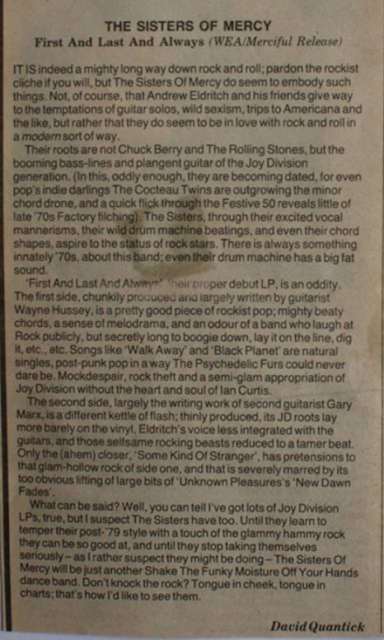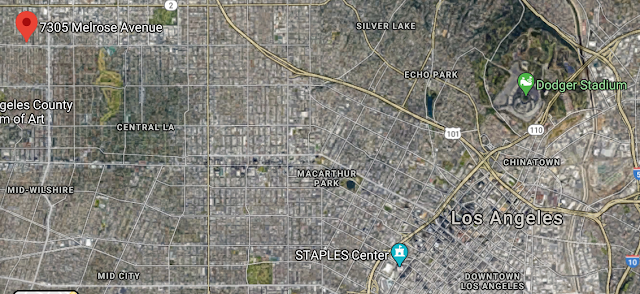Along with how they met and where they got the band name
from, all emerging groups are always asked about their musical influences, as
(lazy?) journalists try to pin down their sound for readers and potential fans,
and The Sisters of Mercy were certainly no exception in their early days.
Andrew Eldritch (almost always the sole spokesperson for the
band until the garrulous – and more experienced - Wayne Hussey joined the group
in late 1983) had clearly anticipated the question, and kept a mental list of
bands which he would trot out, perming any half a dozen from a list that
included The Rolling Stones, The Stooges, Suicide, The Birthday Party, The
Ramones, Motorhead, MC5, The Psychedelic Furs and Hawkwind, to name just some
of the usual suspects.
Apart from the Furs and The Birthday Party, very few
contemporary bands were mentioned as the singer deliberately tried to distance
his band from any of the emerging “positive punk” bands, and interviewers
comparing The Sisters to Bauhaus, for example, or any incarnation of The Cult
were given very short shrift.
However, there was one very obvious comparison, a band whom
the singer seemed reluctant to name-check in the 1980’s, but whose spectre
haunted interviews and reviews of the band in the early days: Joy Division.
There were some obvious points of comparison – both bands had reluctant but
hypnotic frontmen, both singers sang in a low baritone, both had bass players
whose buzzing riffs dominated their sound, both had a clinical, electronic drum
sound, both came from and were resolutely based in the North of England, both
favoured black record sleeves with no photos or details about the band, both
built up fearsome live reputations based purely on word of mouth, and both
played a mean live version of Louie Louie and of the Velvets’ Sister
Ray. Both had ferociously loyal local followings built up by word of mouth,
and knew where they were heading, maintaining some of the mystery essential for
creating a buzz in the music scene, staying away from major label control. The Sisters
early sound was dominated by the guitar of Gary Marx, who played a Shergold – a
brand used by both Bernard Sumner and Peter Hook.
Surely an open and shut case, m’lud. That there were equally
as many differences – whether in terms of influences, vocal tone, lyrical subject
matter, use of humour and irony, guitar style and tone, song structure, visual
image and band management and direction – seemed to matter little to those
eager to pigeonhole TSOM as mere Joy Division copyists.
In the printed media, these comparisons were initially few
and far between (to coin a phrase), but were discussed even in the breakthrough
Sounds cover piece in December 1982, with Eldritch opining “The problem
is these days that there are so few people who sing in a low voice…I mean, when
I started singing people said “Ooh, he sounds just like Jim Morrison,” then
shortly after it was “Ooh, he sounds just like Ian Curtis” and now it’s Pete
Murphy.” Sounds was a particular guilty party, with a review of the Alice
single saying that it was “more obviously JD-derived” , a phrase repeated by
Geoff Barton when he made The Reptile House EP “joint single of the
week” the following year, calling it a “deviant, JD-derived diabolism”. Keeping
with the theme, the paper also including the (rhetorical question) “Is there a
snatch of Ian Curtis?” in their review of First And Last And Always, by
which time such comparisons were clearly redundant as the Sisters moved
inexorably in the direction of Led Zeppelin and classic rock in the hats’n’dry
ice phase which remains their visual (and arguably, musical) zenith.
With Richard “Mr Spencer” Newson (Sounds) and Adam
Sweeting (Melody Maker) very much onside and getting decent copy
published in their respective magazines on a semi-regular basis, the NME
published only short reviews of live shows (normally when they had ostensibly
gone to review another band on the bill) or singles, which were often less than
flattering - ”Choked voice delivers indistinguishable..message” (Body
Electric), “The singer looked like Joey Ramone and yelped like a dog”
(“Christmas on Earth” gig review), “a bit too dense for extended listening” (Alice),
etc.
Already low on Eldritch’s Christmas card list, the NME
further blotted their copy book with Paul Du Noyer’s major interview with the
singer in March 1985, at a time when the band were being widely feted as the
“next big thing”. “An exact definition of their appeal eludes me, but they do
have something” was the best he could muster about a band who had surely earned
their spurs as belated cover stars, a role given to hyped London-based bands
often before a single musical note had been recorded! But this was as nothing compared
to David Quantick’s self-congratulatory review the same month of First And
Last And Always, which broke new records by referencing Joy Division no
fewer than five times in four paragraphs, including in particular a reference to
the similarities between New Dawn Fades and Some Kind of Stranger,
which are not entirely without foundation, it has to be said.
The over-the-top nature of Quantick’s repetition of the JD
reference was picked up on by Piccadilly Radio (ironically based in
Manchester)’s excellent interviewer (Tony “the Greek”?) in a fascinating
encounter with the band during the tour that accompanied the album release. The
singer was only too delighted to expound his views on the NME’s failings
in response, as can be heard in this extract kindly shared online by Phil Verne
of the unofficial The Sisters of Mercy 1980-1985 Facebook fan group. “I think
that they [the NME] feel about us the same way as they felt about Joy
Division. It all happened up here, they missed out on it, they never quite
understood it, they knew it was powerful, but they chose to ignore it and
looked silly afterwards and that’s pretty much the same with us. I think they
lump us in the same category because of that. They regard us as being northern
and industrial and nothing we can ever do will change that because they just
aren’t really interested in promoting rock bands from this part of the world
any more than they ever were, I don’t think,” continued the exasperated singer
at breakneck speed.
With the press finding new bands to persecute about their
likeness to their musical forefathers (hello, Fields of the Nephilim) and focussing
on the Hussey/Eldritch Sisterhood spat, the Joy Division comparisons receded
and have not been heard since. With the passage of time, Eldritch has become
more willing to talk about Joy Division and their occasional similarities to
The Sisters of Mercy, such as in this 2016 seminal interview with John Robb:
“I don't do cover versions. It's the same with Peter Hook. He can't play any other songs at all and he has the best bass riffs other than mine.....That’s where Hooky [Peter Hook, Joy Division bassist] and me are the same – we
just played up and down on one string and wrote songs. Me and Hooky have done
the same thing since then. I loved The Stooges and Suicide and found myself in
a band. I never saw them [Joy Division – who played at the F Club in Leeds] and
if I did, I don’t remember it, but I loved the first album [Unknown Pleasures].
I had their poster on the wall. We were not to the side of Joy Division – we came
from the same place as them. We were from the same place with The Stooges,
Hawkwind and Suicide as the background and from a similar part of the world,
with similar pressures on us, and it was kind of natural that we came up with
something vaguely similar, emitting the [same] moody vibe.” The singer then intones
a familiar “northern powerhouse” monologue which regular interview readers over
the past four decades will be familiar with. “There were whole swathes of the
country that were making that kind of sound – the Sisters called it the M62
sound, because the motorway that connected us to The Teardrop Explodes, Comsat
Angels and all the other bands that we grew up with…that part of the country is
narrow and we were on the same trains and buses and we were connected.”
The final word though must go to Geoff Barton of Sounds,
whose review of what for me was The Sisters’ finest moment, The Reptile
House E.P., ended with the following line: “If Joy Division drew blood. The
Sisters cut right through to the bone. It hurts, but it feels so good.”





